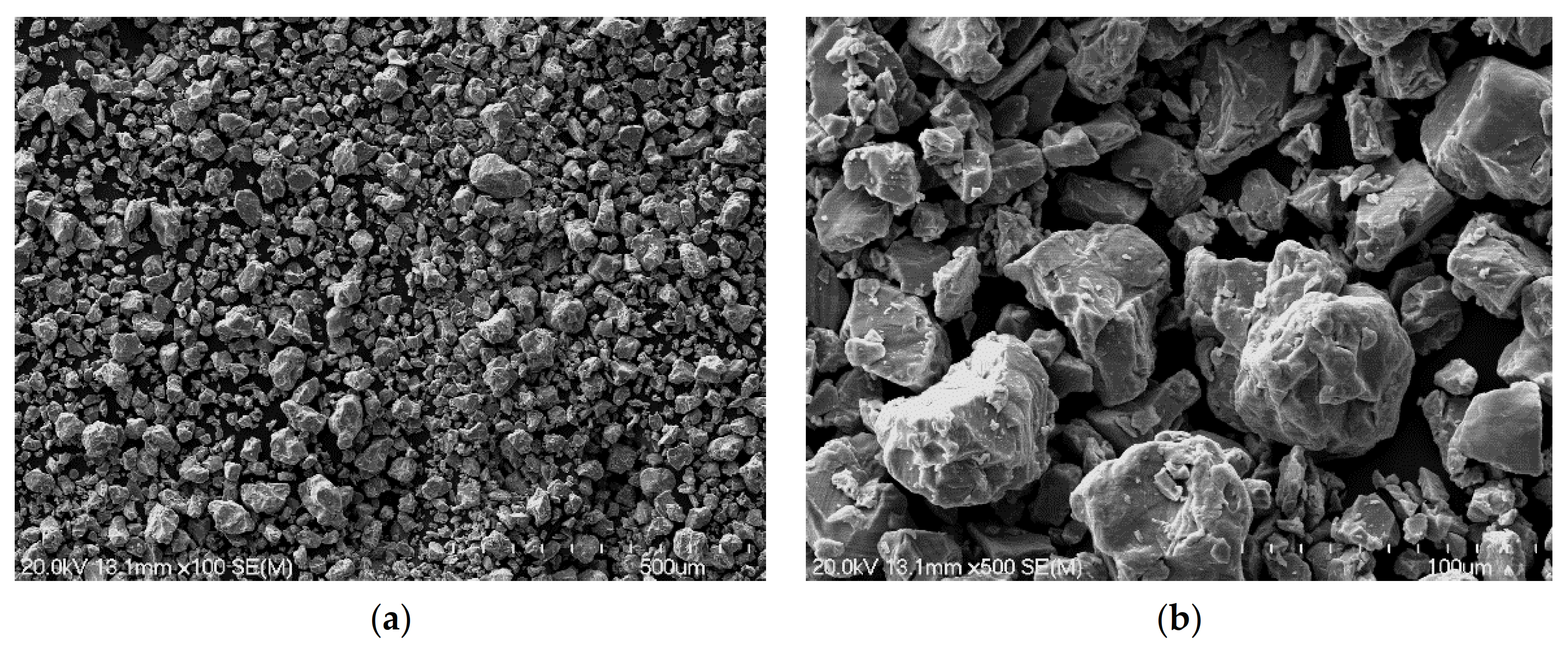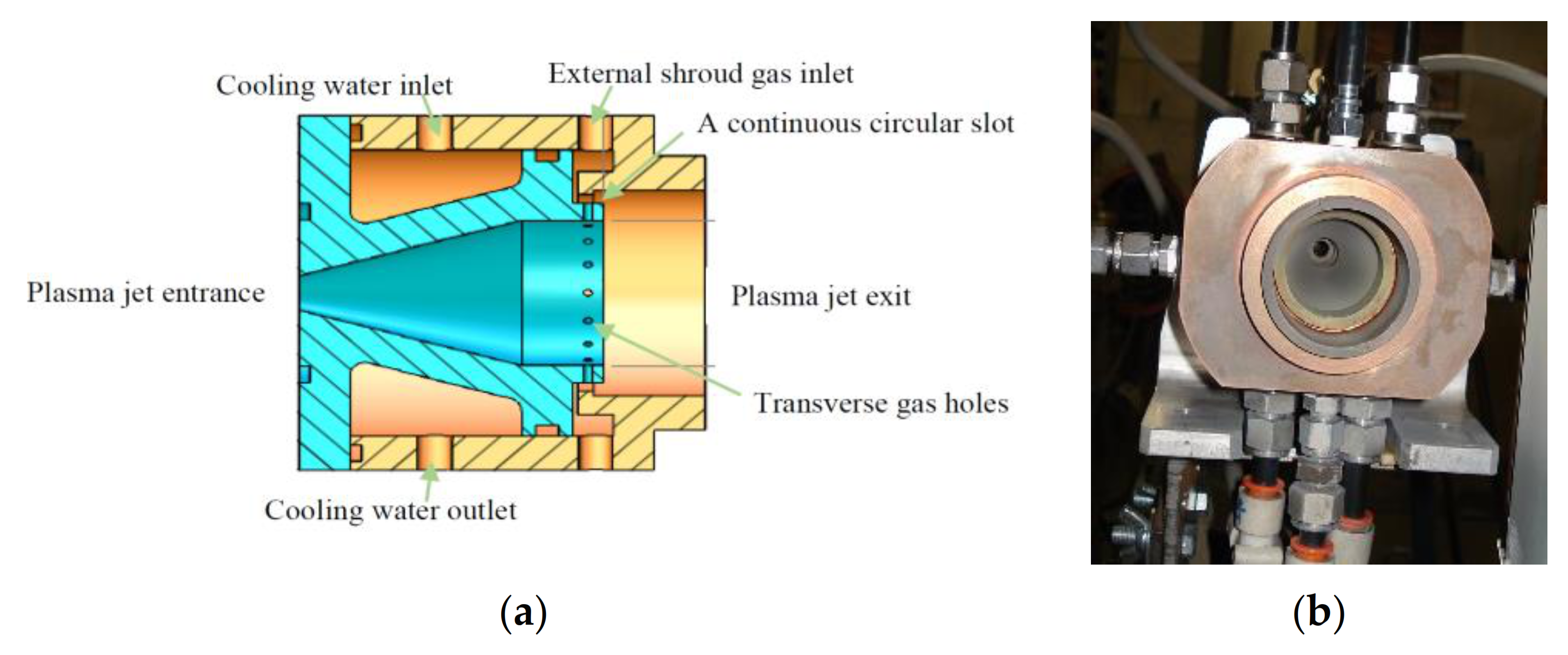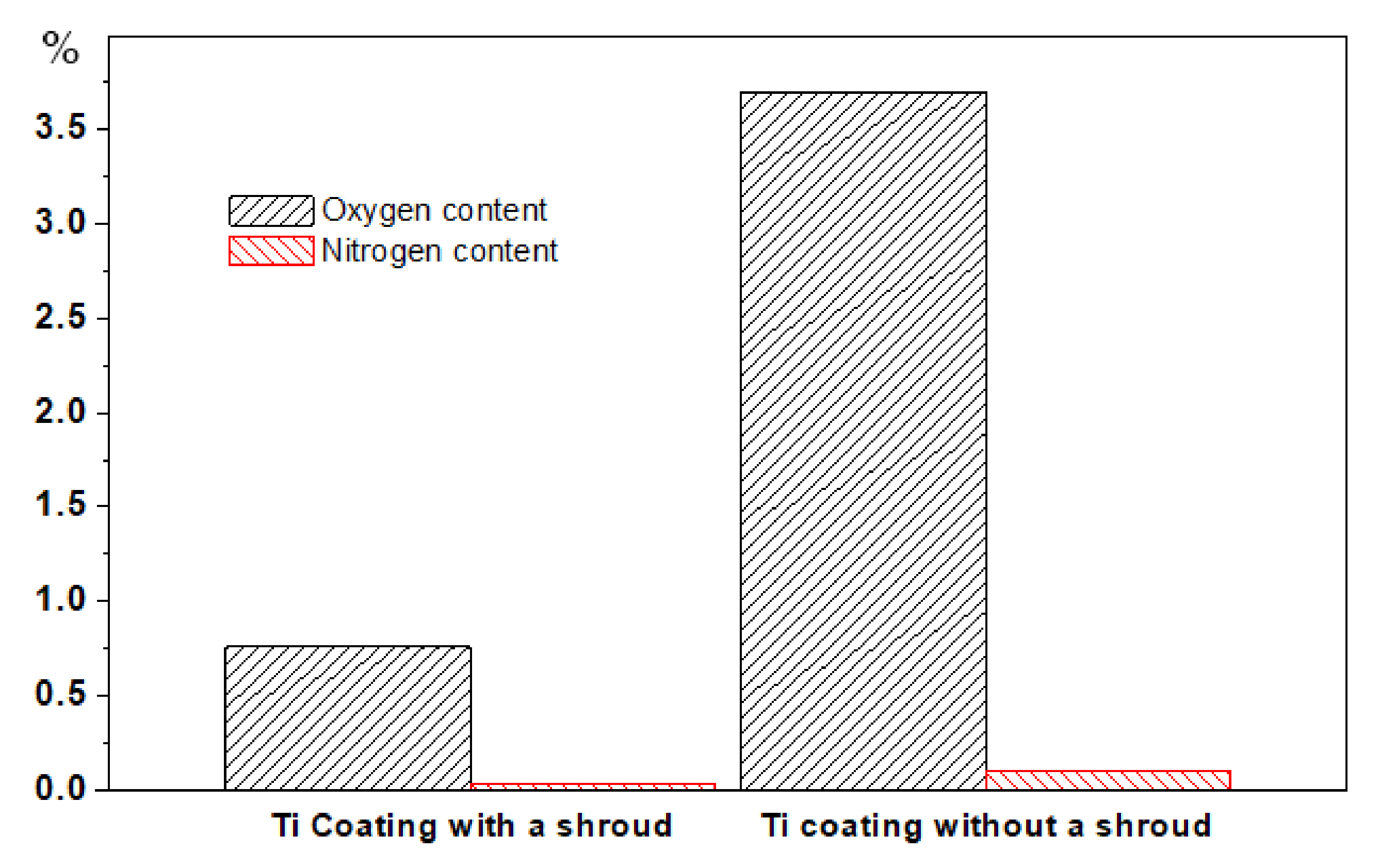Effect of Shroud in Plasma Spraying on Chemical Composition and Thickness of Titanium Coatings
Abstract
1. Introduction
2. Experimental Details
2.1. Materials
2.2. Methods and Material Characterization
3. Results and Discussion
3.1. Coating Microstructure
3.2. Oxygen/Nitrogen Content
3.3. Coating’s Thickness
4. Conclusions
- The nitrogen content was much less than oxygen in both plasma-sprayed titanium coatings with and without the shroud. The nitrogen and oxygen contents in the air plasma-sprayed titanium coatings were obviously higher than those in the shrouded plasma-sprayed titanium coatings.
- The thickness of titanium coating without a shroud was 463 ± 35 μm, and that for the shrouded titanium coatings was increased to 551 ± 38 μm. The deposition efficiency with the shroud was higher than that plasma-sprayed in air, while the shielding effect of the shroud contributed to a better heating condition for the in-flight titanium particles in plasma spraying and led to a higher deposition efficiency.
- The shrouded plasma-sprayed titanium coating held a dense microstructure with a porosity at relatively low level; while the atmospheric plasma-sprayed titanium coating presented a loose microstructure with a relatively high porosity. The presence of the shroud attachment and the inert gas-flow after the shroud brought down the titanium coating’s porosity.
Author Contributions
Funding
Institutional Review Board Statement
Informed Consent Statement
Data Availability Statement
Conflicts of Interest
References
- Banerjee, D.; Williams, J.C. Perspectives on titanium science and technology. Acta Mater. 2013, 61, 844–879. [Google Scholar] [CrossRef]
- Liu, X.; Chu, P.K.; Ding, C. Surface modification of titanium, titanium alloys, and related materials for biomedical applications. Mater. Sci. Eng. R Rep. 2004, 47, 49–121. [Google Scholar] [CrossRef]
- Leyens, C.; Peters, M. Titanium and Titanium Alloys; Wiley-VCH GmbH & Co. KGaA: Weinheim, Germany, 2003; pp. 6–18. [Google Scholar]
- Antunes, R.; de Oliveiraa, M.; Salvador, C. Materials selection of optimized titanium alloys for aircraft applications. Mater. Res. 2018, 21, e20170979. [Google Scholar] [CrossRef]
- Zhou, H.; Gabbitas, B.; Mathews, S.; Zhang, D. Titanium and Titanium Alloy Coatings for Corrosion Protection. In Proceedings of the 12th World Conference on Titanium, Beijing, China, 19–24 June 2011; Volume 3, pp. 1287–1291. [Google Scholar]
- Fauchais, P.; Vardelle, M.; Goutier, S. Latest researches advances of plasma spraying: From splat to coating formation. J. Therm. Spray Technol. 2016, 25, 1534–1553. [Google Scholar] [CrossRef]
- Fauchais, P.; Montavon, G.; Bertrand, G. From powders to thermally sprayed coatings. J. Therm. Spray Technol. 2010, 19, 56–80. [Google Scholar] [CrossRef]
- Kawakita, J.; Kuroda, S.; Fukushima, T.; Katanoda, H.; Matsuo, K.; Fukanuma, H. Dense titanium coatings by modified HVOF spraying. Surf. Coat Technol. 2006, 201, 1250–1255. [Google Scholar] [CrossRef]
- Steffens, H.D.; Erturk, E.; Busse, K.H. A comparison of low-pressure arc and low-pressure plasma sprayed titanium coatings. J. Vac. Sci. Technol. 1985, A3, 2459–2463. [Google Scholar] [CrossRef]
- Ann Gan, J.; Berndt, C.C. Thermal Spray Forming of Titanium and its Alloys. In Titanium Powder Metallurgy: Science, Technology and Applications; Qian, M., Froes, F.H., Eds.; Elsevier: Amsterdam, The Netherlands, 2015; pp. 425–446. [Google Scholar] [CrossRef]
- Lugscheider, E.; Lu, P.; Haeuser, B.; Jaeger, D. Optimized vacuum plasma-sprayed titanium coatings. Surf. Coat. Technol. 1987, 32, 215–226. [Google Scholar] [CrossRef]
- Kitashima, T.; Kawamura, T. Prediction of oxidation behavior of near-α titanium alloys. Scr. Mater. 2016, 124, 56–58. [Google Scholar] [CrossRef]
- Bagot, P.; Radecka, A.; Magyar, A.P.; Dye, D.; Rugg, D. The effect of oxidation on the subsurface microstructure of a Ti-6Al-4V alloy. Scr. Mater. 2018, 148, 24–28. [Google Scholar] [CrossRef]
- Gan, J.A.; Berndt, C.C. Review on the oxidation of metallic thermal sprayed coatings: A case study with reference to rare-earth permanent magnetic coatings. J. Therm. Spray Technol. 2013, 22, 1069–1091. [Google Scholar] [CrossRef]
- Planche, M.P.; Liao, H.; Coddet, C. Oxidation control in atmospheric plasma spraying coating. Surf. Coat Technol. 2007, 202, 69–76. [Google Scholar] [CrossRef]
- Liu, T.; Zheng, L.; Zhang, H. Effect of solid shield on coating properties in atmospheric plasma spray process. J. Therm. Spray Technol. 2016, 25, 1502–1515. [Google Scholar] [CrossRef]
- Morks, M.F.; Berndt, C.C. Corrosion and oxidation properties of NiCr coatings sprayed in presence of gas shroud system. Appl. Surf. Sci. 2010, 256, 4322–4327. [Google Scholar] [CrossRef]
- Kim, S.; Choi, S.; Kim, G.; Hong, S.H. Effects of shroud gas injection on material properties of tungsten layers coated by plasma spraying. Thin Solid Film 2010, 518, 6369–6372. [Google Scholar] [CrossRef]
- Matthews, S. Shrouded plasma spray of Ni–20Cr coatings utilizing internal shroud film cooling. Surf. Coat. Technol. 2014, 249, 56–74. [Google Scholar] [CrossRef]
- Thomson, I.; Pershin, V.; Mostaghimi, J.; Chandra, S. Experimental testing of a curvilinear gas shroud nozzle for improved plasma spraying. Plasma Chem. Plasma Process. 2001, 21, 65–82. [Google Scholar] [CrossRef]
- Jankovic, M.; Mostaghimi, J.; Pershin, V. Design of a new nozzle for direct current plasma guns with improved spraying parameters. J. Thermal Spray Technol. 2000, 9, 114–120. [Google Scholar] [CrossRef]
- Li, J.; Li, C.-X.; Yang, G.-J.; Li, C.-J. Effect of vapor deposition in shrouded plasma spraying on morphology and wettability of the metallic Ni20Cr coating surface. J. Alloys Compd. 2018, 735, 430–440. [Google Scholar] [CrossRef]
- Vetrivendan, E.; Jayaraj, J.; Ningshen, S.; Mallika, C.; Kamachi Mudali, U. Argon shrouded plasma spraying of tantalum over titanium for corrosion protection in fluorinated nitric acid media. J. Therm. Spray Technol. 2018, 27, 512–523. [Google Scholar] [CrossRef]
- Zhou, H.; Liu, Z.; Luo, L. Microstructural characterization of shrouded plasma sprayed titanium coatings. J. Manuf. Mater. Process. 2019, 3, 4. [Google Scholar] [CrossRef]
- Zhou, H.; Liu, Z.; Luo, L. Microstructure and phase composition of titanium coatings plasma sprayed with a shroud. MATEC Web Conf. 2018, 142, 03006. [Google Scholar] [CrossRef]
- Pfender, E.; Fincke, J.; Spores, R. Entrainment of cold gas into thermal plasma jets. Plasma Chem. Plasma Process. 1991, 11, 529–543. [Google Scholar] [CrossRef]
- Luthra, K. Stability of protective oxide films on Ti-base alloys. Oxid. Met. 1991, 36, 475–490. [Google Scholar] [CrossRef]
- Boyer, R.; Welsch, G.; Collings, E. Materials Properties Handbook: Titanium Alloys; ASM International: Metals Park, OH, USA, 1994. [Google Scholar]
- Fauchais, P. Understanding plasma spraying. J. Phys. D Appl. Phys. 2004, 37, 86–108. [Google Scholar] [CrossRef]
- Cheng, K.; Chen, X.; Pan, W. Comparison of laminar and turbulent thermal plasma jet characteristics—A modeling study. Plasma Chem. Plasma Process. 2006, 26, 211–235. [Google Scholar] [CrossRef][Green Version]
- Pfender, E. Fundamental studies associated with the plasma spray process. Surf. Coat. Technol. 1988, 34, 1–14. [Google Scholar] [CrossRef]
- Choi, S.S.; Hwang, T.H.; Kim, D.U.; Seo, J.H.; Kim, K.S.; Hong, S.H. Effects of Anode Nozzle Geometry on Ambient Air Entrainment into Thermal Plasma Jets Generated by a Non-transferred Plasma Torch. In Proceedings of the 30th International Conference on Plasma Science, 2003. ICOPS 2003. IEEE Conference Record—Abstracts, Jeju, Korea, 5 June 2003; p. 388. [Google Scholar] [CrossRef]






| Element | H | O | N | C | Fe | Ti |
|---|---|---|---|---|---|---|
| Ti powder (wt.%) | 0.23 | 0.35 | <0.03 | 0.07 | <0.11 | Bal |
| Spray Parameter | Setting |
|---|---|
| Current, A | 800 |
| Voltage, V | 80 |
| Primary gas, Argon, slpm | 85 |
| Auxiliary gas, Helium, slpm | 18 |
| Powder feed rate, g/min | 30 |
| Spray passes | 10 |
| Spray distance, mm | 100 |
| Transverse speed, mm/s | 500 |
| Shroud gas, Argon, slpm | 300 |
| Nozzle | Mach II—forward injection anode nozzle |
| Titanium Coatings | Oxygen, wt.% | Nitrogen, wt.% |
|---|---|---|
| With the shroud | 0.76 | 0.039 |
| Without the shroud | 3.7 | 0.097 |
Publisher’s Note: MDPI stays neutral with regard to jurisdictional claims in published maps and institutional affiliations. |
© 2021 by the authors. Licensee MDPI, Basel, Switzerland. This article is an open access article distributed under the terms and conditions of the Creative Commons Attribution (CC BY) license (https://creativecommons.org/licenses/by/4.0/).
Share and Cite
Zhou, H.; Peng, C. Effect of Shroud in Plasma Spraying on Chemical Composition and Thickness of Titanium Coatings. Coatings 2021, 11, 446. https://doi.org/10.3390/coatings11040446
Zhou H, Peng C. Effect of Shroud in Plasma Spraying on Chemical Composition and Thickness of Titanium Coatings. Coatings. 2021; 11(4):446. https://doi.org/10.3390/coatings11040446
Chicago/Turabian StyleZhou, Hong, and Cheng Peng. 2021. "Effect of Shroud in Plasma Spraying on Chemical Composition and Thickness of Titanium Coatings" Coatings 11, no. 4: 446. https://doi.org/10.3390/coatings11040446
APA StyleZhou, H., & Peng, C. (2021). Effect of Shroud in Plasma Spraying on Chemical Composition and Thickness of Titanium Coatings. Coatings, 11(4), 446. https://doi.org/10.3390/coatings11040446







